NPE litigation in the first half of 2022 came in slightly ahead of the same period in 2021, with the second quarter making up the difference from a relatively slower Q1-yielding the busiest first half of the year for NPE litigation since 2016. Conversely, patent litigation filed by operating companies fell significantly in the second quarter. Overall patent litigation (including all plaintiff types) essentially matched the first half of last year as a result of the upswing in NPE activity.
USPTO Director Kathi Vidal, meanwhile, has begun to put her stamp on the Patent Trial and Appeal Board (PTAB). In June, Vidal issued the first of a series of promised reforms addressing criticisms over the PTAB's practice of denying institution in America Invents Act (AIA) reviews based on the status of parallel litigation. That new guidance follows other changes under Vidal that have refined the post - Arthrex director review process, as well as the creation of new procedures to insulate the Board's Administrative Patent Judges from political influence. On the other hand, another announced policy shift in the arena of standard essential patent (SEP) licensing went in an unexpected direction with the Biden administration's announcement that it would withdraw a 2019 policy endorsing SEP injunctions without adopting a replacement proposed in late 2021-creating uncertainty for licensors and licensees alike.
The second quarter also saw a number of notable patent transactions, including among NPEs, with some involving assets developed by global technology companies. In related news, BlackBerry's $600M patent sale to Catapult IP Innovations Inc. stalled when the potential buyer failed to meet its financing requirements within a specified time frame-leading BlackBerry to explore "alternative options" for divesting "substantially all of its non-core patent assets". Also newsworthy during Q2-and potentially game changing-were two new standing orders posted by Chief Judge Colm F. Connolly of the District of Delaware, which deal a one-two blow to litigants that wish to keep their funding arrangements and corporate control under wraps.
RPX members will also have exclusive access to a live RPX Community webinar covering highlights from this post; CLE credit may be available. Members can register for this upcoming webinar on RPX Insight.
Litigation Update: NPE Activity Catches Up to 1H 2021 Due to Q2 Boost
Market Sector Update: E-Commerce and Software Saw the Most NPE Litigation in Q2
PTAB Update: Vidal Tackles NHK-Fintiv Rule and Director Review in First Batch of Reforms
FRAND Update: Biden Administration Withdraws 2019 SEP Policy with No Replacement
Litigation Update: NPE Activity Catches Up to 1H 2021 Due to Q2 Boost
For the first half of 2022, NPE activity was slightly ahead of that same period last year by 2%, with 1,203 defendants added to patent litigation campaigns-broadly in line with the trend seen since 2018. While Q1 2022 saw 10% less litigation compared to an unusually active first quarter last year, NPEs more than made up the difference in Q2 2022, which was up by 13% from Q2 2021. As a result, NPEs had their busiest first half of the year since 2016. The contribution of prolific monetization firm IP Edge LLC held steady once again, accounting for about 25% of the NPE campaign defendants added in 1H 2022.
In contrast, operating companies added 522 defendants in the first half of the year, or 8% below the same period in 2021. The decline was even steeper when excluding Abbreviated New Drug Application (ANDA) litigation targeting generic drug makers, at 17% (with 432 defendants added to non-ANDA operating company litigation in 1H 2022, compared to 520 in 1H 2021).
With no filter for plaintiff type, 1,725 defendants were added to patent litigation campaigns in the first half of 2022, or about the same amount as the first half of last year (1,753).

NPEs added 676 defendants to litigation campaigns in Q2 2022-up 13% from the same quarter last year (as noted above) and up 28% from Q1, beating the trailing second-quarter 2019-2021 average by 17%. In the second quarter of 2022, NPEs were responsible for 73% of all patent litigation.
Meanwhile, operating companies added 254 defendants in the fourth quarter, which was 21% below the year-ago quarter, 5% lower than Q1, and 24% lower than the trailing average. Operating companies accounted for 27% of all patent litigation in 1H 2022.
| Defendants Added | Change Compared to: | ||||
| Q2 2022 | Q2 2021 | Q2 2019-2021 Average | Q1 2022 | ||
| NPE | 676 | 13% | 17% | 28% | |
| Operating Company | 254 | -21% | -24% | -5% | |
| Total | 930 | 1% | 2% | -17% | |
Overall, with no filter for plaintiff type, 930 defendants were added to patent suits in Q2, roughly equal to the amount of litigation filed in the second quarter of 2021, 17% more than the prior quarter, and about 2% more than the trailing average.
As noted in prior reports, the operating company data above exclude another distinct category of litigation filed by a small group of design and utility patent owners targeting copycats and counterfeiters selling products online. RPX excludes such "e-seller" cases from analyses of district court litigation because they tend to follow a different dynamic compared to a typical patent suit: These e-seller cases sometimes name hundreds of defendant entities, many of which may be merely online storefronts for the same ultimate parent. Additionally, plaintiffs mainly seek injunctive relief instead of damages, and their cases often end with the e-seller defendant's failure to answer, followed by a default judgment.
This category of litigation, which began to spike in Q3 2020, is shown in grey below to illustrate its magnitude. As evident from the rightmost bar, e-seller litigation in Q2 2022 was nearly as high as it was in Q3 2020, at 1,562 defendants added-accounting for 63% of all litigation during the quarter (subject to the caveat about defendants with multiple online storefronts noted above).
Please note that apart from the graph below, the remaining analyses in this report exclude pure design patent and e-seller litigation.
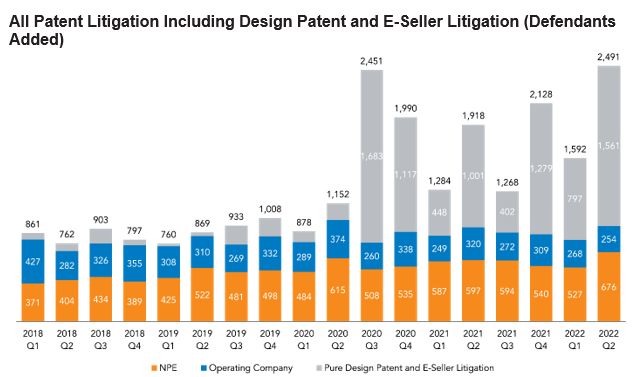
Venue Update: West Texas Stays on Top as Federal Circuit Rejects Judge Albright's Transfer Workaround
In Q1 2022, the Western District of Texas was yet again the most popular district for all patent litigation and for litigation filed by NPEs. The District of Delaware was the top district for operating company litigation and held second place for all litigation. However, Delaware fell to number three for NPE litigation, outpaced by the Eastern District of Texas (which held third place for all litigation).
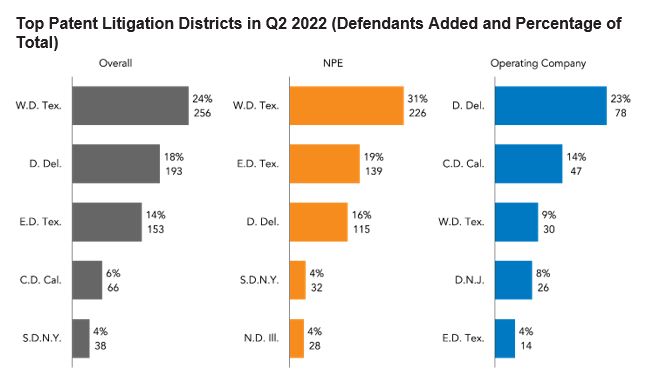
At present, the District of Delaware has three active district judges-Chief Judge Colm F. Connolly and District Judges Richard G. Andrews and Maryellen Noreika-following the recent confirmation of former District Judge Leonard P. Stark to join the Federal Circuit. On April 13, President Biden nominated Fox Rothschild partner Gregory B. Williams-an experienced patent litigator-to fill the vacancy left by Judge Stark. The state's two US senators, Tom Carper and Chris Coons (both D-DE), issued an endorsement that same day touting his "broad federal court experience, including with intellectual property and corporate law". Williams, who has served as a special master for the District of Delaware since 2020, is also a former president of the Delaware State Bar association.
The Senate Judiciary Committee held a hearing on Williams's nomination on May 11. Written questions posed to the nominee by committee members largely focused on topics not related to patent litigation, though Williams did state that he does "not believe it is appropriate for judges to take any steps with the intention of attracting a particular type of case or litigant" in response to a question about "forum selling" from Senator Thom Tillis (R-NC)-in context, a reference to Senator Tillis's criticisms of the practices of District Judge Alan D. Albright of West Texas (who is discussed further below). Williams cited the need to avoid commenting on hypotheticals in declining to answer questions on the Federal Circuit's mandamus jurisprudence (also a reference to Judge Albright) and on the state of the law on patent eligibility.
On June 9, the Judiciary Committee voted favorably on Williams's nomination, with Senator Richard Durbin (D-IL) adding the nomination to the Senate's Executive Calendar-likely teeing the nomination up for a full Senate vote in the near future.
Judge Albright, Again the Nation's Top Patent Judge, Gets Further Pushback from Federal Circuit
The top judge in Q2 2022 was Judge Albright, with 25% of new litigation filed in his courtroom. Judge Albright-who has gone to great lengths to attract patent litigation, drawing the ire of Congress in the process-has shown a restrictive approach to various defensive motions. Among other such tendencies, Judge Albright has expressed an aversion to granting motions to stay pending the outcome of PTAB trials and an inclination against granting patent eligibility challenges early in the course of litigation.
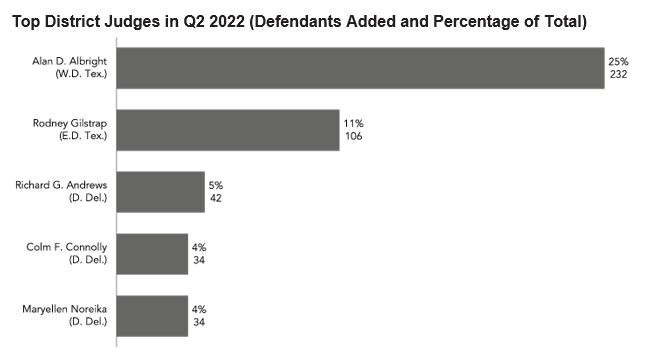
Perhaps the most ink, however, has been spilled over his handling of requests to transfer litigation to other districts-especially on convenience grounds, under 28 USC Section 1404. Judge Albright has largely tended to deny convenience transfer motions, applying the substantive factors underpinning the required analysis in a manner that has frequently led to objections from the Federal Circuit. As detailed in RPX's first-quarter report, the appellate court has repeatedly reversed Judge Albright's transfer decisions on mandamus, doing so 18 times last year-often flagging a series of repeated legal errors that he has made despite the court's ongoing criticism.
While that wave has slowed to a steady trickle, one recent opinion-the second such reversal by the Federal Circuit this year-suggests that Judge Albright's approach is still not to the court's liking. On May 26, the Federal Circuit held that Judge Albright erred by denying Apple's motion to transfer a case filed against it by BillJCo LLC, despite his use of revised arguments that cited the appellate court's prior mandamus rulings against him, concluding that he had made a similar set of legal errors in his application of the relevant factors. Among those repeated errors were his characteristic emphasis on his district's quick time to trial for the "court congestion" factor, notwithstanding his newfound reliance on actual trial timing statistics versus speculative, scheduled dates; and his overemphasis on a defendant's general presence in a district for the "local interest" factor, rather than focusing on acts related to the "events that gave rise to a suit". More details can be found on RPX Insight.
Market Sector Update: E-Commerce and Software Saw the Most NPE Litigation in Q2
The top market sector for NPE litigation in Q2 2022 was E-Commerce and Software, accounting for 28% of new defendants added to patent litigation campaigns. Consumer Electronics and PCs saw the second highest amount of NPE litigation in the second quarter, followed by Networking, Media Content and Distribution, and Semiconductors.

NPE activity hitting the E-Commerce and Software sector in Q2 included litigation from several well-known plaintiffs as well as smaller entities and individual inventors.
Among those campaigns were several hitting web content and analytics technologies. In April, R2 Solutions LLC, a subsidiary of publicly traded Acacia Research Corporation, filed a new round of suits over patents from the large former Yahoo portfolio that Acacia acquired in 2019 through Excalibur IP, LLC, targeting search query processing and analytics features from web platforms and mobile apps offered by American Airlines, Citigroup, CVS, and Hilton. Another familiar player targeting website search functionality was monetization firm IP Edge LLC, via controlled plaintiff Ridgeview IP LLC, which in late April kicked off a campaign against the purveyors of several online learning and research websites offering such features.
Additional web-related campaigns that saw new litigation in Q2 included two related to user interface features. In late May, Lexos Media IP, LLC revived its campaign against e-commerce retailers, filing a new wave of complaints targeting features for displaying a zoomed section of a product image in place of the user's cursor when it rolls over the image. Meanwhile, websites with hierarchical/nested menus are at issue in the latest batch of litigation filed in May by co-plaintiffs Caddo Systems, Inc. (the inventor-controlled owner of the asserted patents) and 511 Technologies, Inc. (their exclusive licensee), followed weeks later by the issuance of an infringement verdict in an earlier West Texas lawsuit from that same campaign.
Other NPEs hitting this sector in Q2 focused on location-based technologies and related products. Those plaintiffs included monetization firm Equitable IP Corporation, which through subsidiary Route Guidance Systems LLC has targeted a range of products with GPS navigation features-including vehicle infotainment systems, telematics systems, and mobile apps-in a three-year-old campaign that saw new suits in early May. Another familiar plaintiff, inventor-controlled Traxcell Technologies, LLC, focused more on the use of location services in delivery and rental services in a set of late-June complaints, hitting apps with features related to tracking arrival times and locations of ridesharing drivers and delivery orders as well as locating available scooters for rental. Additionally, new plaintiff Surge Tech, LLC launched a campaign hitting one of those same ridesharing defendants over features allowing surge pricing, with public records suggesting that the plaintiff has the backing of a "boutique litigation funder".
Products related to online communications and social media were also at issue in other NPE litigation hitting the E-Commerce and Software sector this past quarter-including the campaign waged by Peter Henrik Pedersen, which in April saw the inventor add a new set of cases to the email management campaign he launched in November 3021. Earlier that month, inventor-controlled plaintiff Wireless Discovery LLC sued several providers of dating apps and services in Delaware, switching to a second asserted claim after Judge Albright invalidated the claim at issue in a first round of West Texas cases against those same defendants. That same day, another inventor-controlled NPE, Face to Face Biometrics, Inc., sued Apple over the provision of various iPhones and iPads that support sending "Memoji" - emoticons with animations based on the user's facial expressions-over the iMessage messaging service.
PTAB Update: Vidal Tackles NHK-Fintiv Rule and Director Review in First Batch of Reforms
In the first half of 2022, 688 petitions for America Invents Act (AIA) review were filed with the PTAB, including 669 petitions for inter partes review (IPR) and 19 petitions for post-grant review (PGR). Filings in the year's first half were 1.4% lower than during the same period in 2021.
The second quarter saw 352 petitions for AIA review, including 341 IPR petitions and 11 petitions for post-grant review (PGR). Filings in Q2 were 4.8% higher than in the prior quarter (when 336 petitions were filed) but 2.5% lower than in Q2 2021 (which saw 361 petitions).
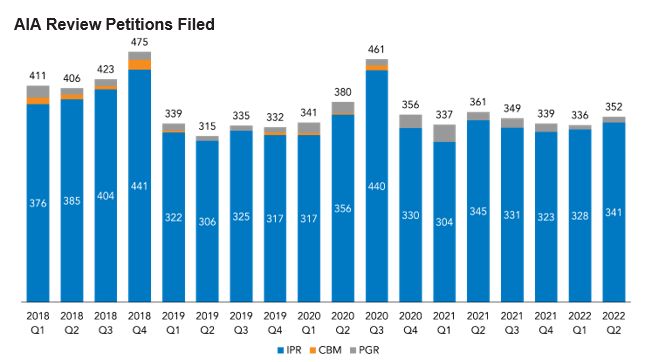
Additionally, the PTAB instituted trial in 66% of the AIA review petitions addressed in the first half of 2022, up from 59.8% in the same period last year and 59% for all of 2021. The institution rate in the second quarter of 2022 alone was 71%.
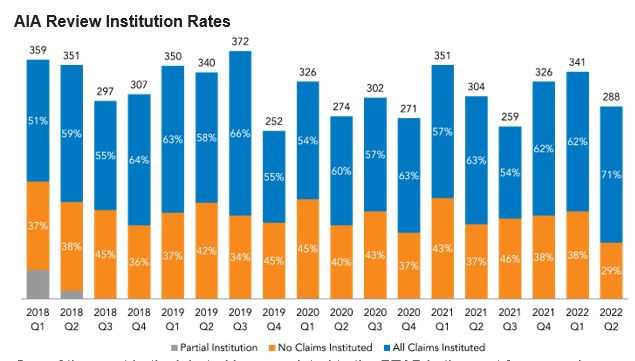
One of the most hotly debated issues related to the PTAB in the past few years has been the Board's practice of discretionarily denying institution for reasons other than the merits, based on a series of factors-collectively known as the NHK-Fintiv rule-that allow the Board to consider the status of parallel district court litigation. Ever since USPTO Director Kathi Vidal's April confirmation, stakeholders have watched closely for signs of how she would address concerns over NHK-Fintiv, and she has now taken some initial steps to limit the rule's application.
On June 21, Vidal issued an interim guidance that in part seeks to mitigate the impact of one of the NHK-Fintiv rule's most controversial factors, factor two, under which the PTAB may reject a petition if the district court's scheduled trial date falls too close to the deadline for the Board's final validity decision. This factor can be especially problematic from a strategic perspective because it forces petitioners to file as early as possible-effectively further compressing the one-year window defendants already have to file an IPR-based on an aspect of litigation, trial scheduling, that is inherently outside of a petitioner's control. Moreover, critics of this factor (among them Senator Tillis, otherwise an NHK-Fintiv supporter) have faulted the Board for relying on the date when trials are scheduled as opposed to when they ultimately take place, since scheduled dates can often get pushed back due to a variety of factors-a particular problem during the early days of the COVID-19 pandemic.
Vidal's new guidance acknowledges those concerns, agreeing with critics that because scheduled dates are "unreliable" and frequently change, such a date is "not by itself a good indicator of whether the district court trial will occur before the statutory deadline for a final written decision". As a result, Vidal established that trial time alone cannot tip the scales toward denial under NHK-Fintiv: "when other relevant factors weigh against exercising discretion to deny institution or are neutral, the proximity to trial should not alone outweigh all of those other factors". Moreover, Vidal declared that trial dates must instead be considered based on the district's actual, median time to trial, alongside other factors including the caseload of the judge in the parallel litigation as well as the "speed and availability of other case dispositions".
The guidance also establishes other limitations on NHK-Fintiv, chief among them a rule that essentially exempts AIA reviews that are especially likely to succeed from discretionary denials on that basis. While Vidal stated that while the PTAB will retain the discretion to deny institution under NHK-Fintiv factor six (considering the merits of the petition) where evidence of invalidity is "merely sufficient to meet the statutory institution threshold", the Board "should not discretionarily deny institution" for petitions presenting "compelling, meritorious challenges": "those in which the evidence, if unrebutted in trial, would plainly lead to a conclusion that one or more claims are unpatentable by a preponderance of the evidence".
Additionally, Vidal's guidance memorializes two other practices that have developed as a result of NHK-Fintiv. First, Vidal established that only district court litigation may be considered under NHK-Fintiv, not investigations before the International Trade Commission (ITC), confirming that the current practice of doing so is consistent with the text and intent behind the rule.
Second, Vidal gave her seal of approval to the PTAB's practice of allowing parties to stipulate around NHK-Fintiv factor four, under which the Board may deny a petition if it contains the "same or substantially the same claims, grounds, arguments, and evidence" as a district court invalidity challenge. That practice has arisen as a result of two key PTAB decisions, as noted in RPX's last quarterly report. In Sand Revolution II v. Continental Intermodal Group - Trucking (issued May 2020; designated as informative that July), the PTAB granted institution after the petitioner agreed not to assert the same invalidity grounds in district court that it did in its IPR petition. That same December, the Board accepted an even broader type of stipulation in its Sotera Wireless v. Masimo decision (designated as precedential two weeks later), after the petitioner informed the district court that it would not pursue "any ground raised or that could have been reasonably raised in an IPR" after institution. Vidal endorsed the latter category (calling them "Sotera [s]tipulations", described in related materials as " Sand/Sotera stipulations"), explaining that these "mitigate[] concerns of potentially conflicting decisions and duplicative efforts between the district court and the PTAB". As a result, Vidal stated that "the PTAB will not discretionarily deny institution of an IPR or PGR in view of parallel district court litigation where a petitioner stipulates not to pursue in a parallel district court proceeding the same grounds as in the petition or any grounds that could have reasonably been raised in the petition".
Companion Study Illustrates NHK-Fintiv's Impact
Also released alongside Vidal's guidance was a USPTO study on parallel litigation that provided data on how the NHK-Fintiv rule has played out in practice (with an accompanying executive summary as well an appendix providing tabular data and methodology). The study revealed that after the Fintiv decision was designated as precedential in May 2020 (with its companion NHK Spring decision having been so designated one year prior), parallel litigation was raised in 40% of all AIA review proceedings (meaning that either the institution decision analyzed NHK-Fintiv, or the patent owner argued for discretionary denial under NHK-Fintiv in its preliminary response, prior to the denial of institution on other, merits-related grounds). Additionally, the study found that NHK - Fintiv denials peaked in the first quarter of 2021 and "dropped significantly afterwards".
Indeed, the data shown in the study indicate that the PTAB issued just six NHK-Fintiv denials in Q4 2021, compared to 85 decisions granting institution after analyzing NHK-Fintiv. (Note that the time periods discussed in the study refer to the USPTO's fiscal year, which begins on October 1-so, e.g., the second quarter of fiscal year 2021 corresponds to Q1 2021 for the calendar year. This report, including the graphs below, adapts fiscal year dates to the calendar year.)
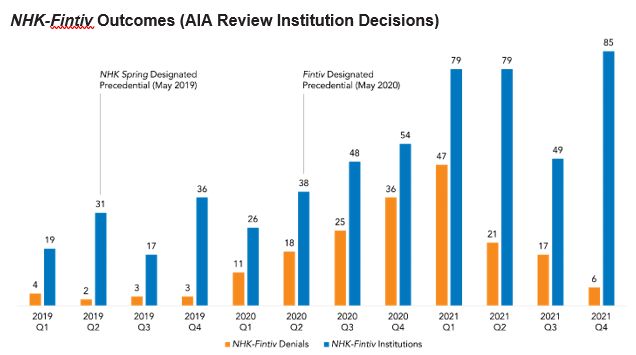
The USPTO also included a breakdown of NHK-Fintiv decisions by the venue of parallel district court cases, focusing on the three districts accounting for the bulk of such decisions: the Western and Eastern Districts of Texas and the District of Delaware. That breakdown revealed one rather surprising conclusion. While the Western District of Texas has been a focal point in the NHK-Fintiv debate due to Judge Albright's focus on scheduling early trial dates-and, indeed, his venue was the one most discussed in NHK-Fintiv decisions-it had not seen an NHK-Fintiv denial based on parallel litigation since August 2021. West Texas was also the district with the lowest rate of NHK-Fintiv denials among the top three, at 16.1% (or 29 denials out of the 180 total institution decisions counted). The Eastern District of Texas had a much higher denial rate at 55.7% (or 83 of 149 total decisions), with Delaware the lowest at 11.2% (13 of 116 decisions total).
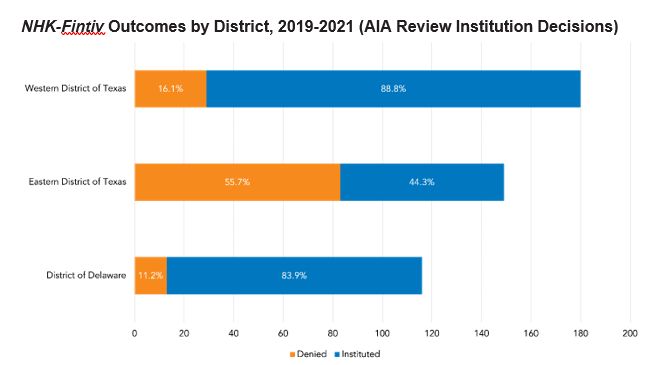
The study further quantified the impact of the Sand/Sotera stipulations endorsed in Vidal's guidance, showing that challengers agreeing to such estoppel in district court are now much more likely to have their petitions instituted. In particular, the data show that for institution decisions that noted such stipulations, the grant rate has increased significantly-going from 61.3% in Q1 2021 (the first full quarter since the Sotera decision was designated as precedential) to 97.1% in Q4. The statistics also reflect a corresponding increase in the number of institution decisions noting such stipulations.
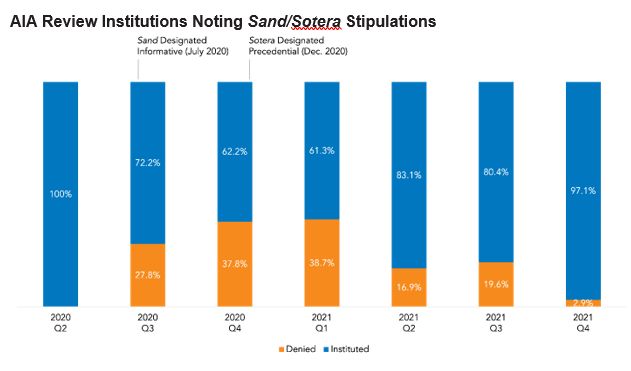
Defendants Still Filing More Reexam Requests Despite Dip in NHK-Fintiv Denials
While the USPTO's study confirms that NHK-Fintiv denials have decreased, and that defendants have avoided some aspects of NHK-Fintiv via stipulations, it also shows that patent owners are still raising the rule in a rising number of AIA reviews despite the lower chance of success-doing so in 50.6% of AIA reviews that saw institution decisions in Q4 2021.
Given that remaining uncertainty, it is perhaps not surprising that some would-be petitioners have instead been filing increasingly more ex parte reexaminations instead of AIA reviews. Reexams are not subject to the same level of discretionary denials and offer a variety of other advantages compared to AIA reviews, such as lower cost and the lack of estoppel altogether-no stipulations required.
As shown below, parties filed 331 reexam requests in 2021, 53.2% more than they did the year prior-and that trend appears to be continuing in 2022. The second quarter saw 93 new requests for reexam, a 27.4% jump from Q2 2021. With that upswing in second-quarter filings, the first half of the year is 13.1% ahead of that same period in 2021. A rising share of the patents subject to reexam requests were also previously challenged through AIA reviews, reaching 38% in the first half of 2022, up from 36% in 2021, 33% in 2020, and 25% in 2019. Additionally, the share of patents with reexam requests that have also been asserted in parallel district court litigation also remains high, at 62% in the first half of the year-a slight dip from 2021's 64%, but still higher than 2020's 60% and 2019's 52%.
This high degree of overlap with AIA reviews and district court litigation strongly suggests that the uptick in reexam requests is the result of the NHK-Fintiv rule discouraging defendants from filing AIA reviews.
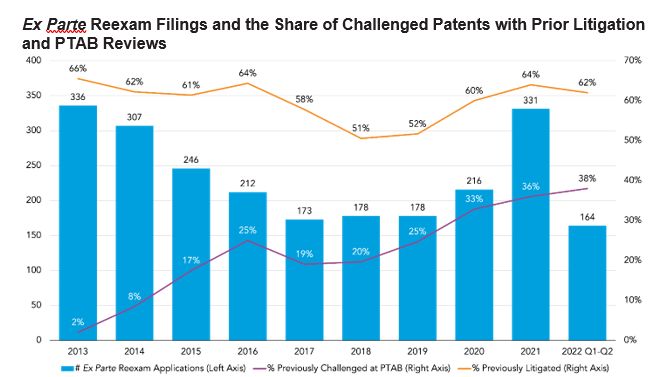
Note: Data as of July 4, 2022. Due to the delayed availability of filing dates and related data from the USPTO, this analysis is subject to change.
Congress Weighs Legislative Reform
Vidal's new guidance comes as Congress considers legislative proposals to reform the PTAB-including a new Senate bill that would eliminate the NHK-Fintiv rule. That bill, the Patent Trial and Appeal Board Reform Act of 2022, was introduced on June 16 by Senators Patrick Leahy (D-VT), John Cornyn (R-TX), and Tillis. The proposed law also includes provisions designed to counter alleged gamesmanship at the PTAB and would pay the expert witness fees and attorney fees for certain "small" and "micro" entities that have not asserted their challenged patents in litigation. In announcing the bill, Senator Tillis described it as a "carefully crafted compromise requiring sacrifices from both sides of the issues", adding at a June 22 hearing on PTAB reform, "[i]f you don't like the compromise we've come up with, tell us. But don't just tell us you hate it. Give us ideas on how to write a better bill that will, in your opinion, be a better compromise".
Alleged abuses of the patent system, the need to encourage innovation, and a variety of specific PTAB issues were at the forefront in Kathi Vidal's confirmation process, during which Senator Tillis and other members of the Senate Judiciary Committee questioned her about NHK-Fintiv, patent eligibility, "judge shopping", SEP licensing, and a variety of other patent issues. For details on Vidal's responses in her capacity as a then-nominee, see RPX Insight.
Vidal Clarifies Post - ArthrexDirector Review Process
Vidal has also taken steps to further clarify the metes and bounds of the director review program created as a result of the Supreme Court's June 2021 decision in Arthrex. That opinion, considering whether the PTAB's appointment of Administrative Patent Judges was unconstitutional, left the Board largely intact but gave the USPTO director the authority to rehear final validity decisions in AIA reviews. The Patent Office implemented that holding through an interim director review program created shortly after the decision's issuance, laying down certain procedural and substantive requirements the following month.
In April 2022, soon after her confirmation as USPTO director, Vidal announced that the USPTO would be seeking to formalize the director review program after stakeholder input through an official Request for Comment filed in the Federal Register. Alongside Vidal's announcement, the USPTO also further detailed what issues can form the basis of a director review request, including intervening changes in law, USPTO procedures, or guidance; "material errors of fact or law" in PTAB decisions; "novel issues of law or policy"; "issues on which PTAB panel decisions are split"; "issues of particular importance to the Office or patent community"; or "inconsistencies with USPTO procedures, guidance, or decisions". On June 22, the USPTO updated that guidance to indicate that parties should highlight issues of first impression when seeking director review.
Relatedly, the USPTO has also begun providing official statistics on director review to promote transparency, indicating that it has rarely granted such review-doing so for just seven of the 186 requests decided thus far. The USPTO plans to update this data each month.
Director Review and Allegations of Gamesmanship
In addition, Vidal has also begun to address criticisms from members of Congress and other stakeholders regarding allegations of abuse or gamesmanship in the IPR process.
Those criticisms have focused lately on IPRs filed by Open Sky Industries and Patent Quality Assurance (PQA) against VLSI Technology LLC, which Senators Mazie Hirono (D-HI) and Thom Tillis (R-NC) characterized as using the IPR system for financial gain. In an April letter to Vidal asking her to take action against such practices, the senators deemed the motives of Open Sky, in particular, as "suspect" based on an email regarding settlement discussions that VLSI filed with the USPTO. They characterized that email as proposing that Open Sky "would actively work to undermine the IPR it brought-thereby protecting VLSI's patents from other challenges-in exchange for monetary payment". The senators flagged this email and other allegedly problematic aspects of the IPRs, including the fact that the PTAB proceeded to institute two of them.
Vidal responded to the senators on May 27, saying that she had begun working on this "important" issue shortly after her confirmation and informing them that the "USPTO is revisiting its related practices and procedures to make clear that abuses of the IPR process will not be tolerated", though she did not detail the initiatives under consideration.
In the meantime, Vidal has initiated director review in IPRs from Open Sky and PQA, doing so sua sponte (i.e., at her own initiative, without the request of a party) for the first time since the interim director review program was established under her predecessor. While the filings announcing those decisions did not provide many specifics, Vidal did argue in both that director review was "appropriate because this case raises novel issues of law and policy, as well as issues of particular importance to the Office and the patent community".
New Process Insulates PTAB Panels from Perceived Director Influence
Another issue that has faced the PTAB is the perception that the USPTO director may wield her authority to influence the outcomes of AIA review decisions. In May, Vidal took steps to address this concern by announcing a new interim process for reviewing the decisions of PTAB panels in AIA reviews prior to issuance. Under that new process, a Circulation Judge Pool (formerly known as the AIA Review Committee) comprised of at least eight non-management peer judges review and provide feedback on pending decisions. The process is modeled in part after the Federal Circuit's ten-day circulation process but differs in one key respect: while Federal Circuit review can result in a decision being blocked, here it is the original PTAB panel that has the authority to makes the final decision. More importantly, the "interim process makes clear that the Director is not involved, pre-issuance, in directing or otherwise influencing panel decisions".
FRAND Update: Biden Administration Withdraws 2019 SEP Policy with No Replacement
Among the biggest news on standard essential patent (SEP) licensing in Q2 was the decision by the US Department of Justice (DOJ), the National Institute of Standards and Technology (NIST), and the USPTO to withdraw a 2019 policy statement endorsing the availability of injunctive relief in SEP disputes. Notably, the Biden administration neither reinstated a prior 2013 policy statement focused more on patent owner hold-up, nor adopted a replacement proposed this past December that attempted to bridge the gap between the two-leaving no policy in place, in favor of a case-by-case approach.
As detailed in RPX's prior coverage, the 2013 joint policy statement, issued by the Antitrust Division of the Justice Department under President Barack Obama alongside the USPTO but not the NIST, focused on the anticompetitive effects of injunctive relief as used to gain leverage in SEP licensing disputes. While the statement acknowledged that SEP injunctions may be appropriate in some circumstances, it argued that such relief would be against the public interest where the accused infringer is "acting within the scope of the patent holder's [commitment to license its patents on fair, reasonable, and non-discriminatory (FRAND) terms] and is able, and has not refused, to license on [FRAND] terms".
In late 2018, Assistant Attorney General Makan Delrahim - the head of the Antitrust Division under President Donald J. Trump - announced the DOJ's withdrawal from the 2013 policy statement, stating that the prior policy viewing SEP injunctions as potentially anticompetitive was "wrong as a matter of antitrust law and bad as a matter of innovation policy". A new joint policy statement followed in December 2019, with the DOJ, USPTO, and NIST this time arguing that injunctions should be available in SEP disputes. In particular, the statement asserted that a SEP holder's FRAND commitment should not bar any "particular remedy", that both injunctions and damages should be on the table for SEP infringement disputes, and that there should be no special rules for remedies in SEP suits.
The joint policy statement proposed in December 2021, following President Biden's order to revisit the 2019 policy, walked back certain key aspects of the prior statement. Perhaps most notably, the proposal asserted that injunctions should not be issued in SEP cases when monetary damages are available. On the other hand, as detailed in RPX's analysis, the draft policy also included recommendations related to alleged implementer misconduct, building on prior statements from Biden DOJ officials favoring a policy that balances the interests of both licensors and licensees. The new proposal sparked a heated debate among stakeholders during the official public comment period, with the government receiving over 1,000 comments in total by the early February deadline-including 167 commentspublished online. Among them were statements both in support and in opposition from members of Congress, feedback largely in favor from tech companies, calls from certain patent pools to treat such licensing programs differently, and arguments in opposition from various patent licensors.
On June 8, 2022, the DOJ, USPTO, and NIST announced that after considering this feedback, they had decided to withdraw the 2019 policy statement rather than make revisions, stating that this would be "the best course of action for promoting both competition and innovation in the standards ecosystem". Instead, the agencies argued that an efficient SEP licensing system, "technological innovation", "consumer choice", and "industry competitiveness" can all be achieved through the courts' administration of US law under the Constitution, statutes, and regulations, as also enforced by the DOJ and other agencies-with the DOJ to "review conduct by SEP holders or standards implementers on a case-by-case basis to determine if either party is engaging in practices that result in the anticompetitive use of market power or other abusive processes that harm competition".
What Comes Next
The agencies' decision to move forward without a set policy leaves significant uncertainty in its wake, though in the short term it is clearer what to expect for injunctions-mainly because the 2019 policy (which did not have the force of law) does not appear to have prompted courts to rethink their position on such relief in SEP cases. The governing caselaw thus remains the same for SEP suits as in all other patent suits: the Supreme Court's decision in eBay v. Merc Exchange, under which courts apply a set of equitable factors in deciding whether to grant permanent injunctions. Courts have typically found that one of the eBay factors-requiring the patent owner to show that it would suffer "irreparable harm" without an injunction-is hard to overcome for SEP owners subject to a FRAND commitment, where the patent owner has agreed to "widely license" the patent at issue. That will likely remain the case in district court SEP litigation for the foreseeable future unless courts decide to revisit eBay in the context of SEP litigation.
However, a different issue faces the ITC, which can only issue exclusion orders (injunctions blocking the importing of infringing products) in patent infringement litigation brought under Section 337. In May, Federal Trade Commission (FTC) Chair Lina Khan, joined by Commissioner Kelly Slaughter, filed a public interest statement in an ITC investigation over cellular communications modules, expressing concerns that SEP owners would use the threat of ITC exclusionary orders to gain undue leverage against existing or potential licensees. Khan and Slaughter argued that when a SEP licensor "can be made whole through remedies in a different U.S. forum" - i.e., through damages issued by a district court-"an exclusion order barring standardized products from the United States will harm consumers and other market participants without providing commensurate benefits". While the ITC decided not to revisit its initial noninfringement ruling on July 7, the question remains whether the Commission will issue a SEP exclusion order in a future case in the absence of an executive-branch policy concerning injunctions-and whether the Biden administration might block the enforcement of such an injunction in the name of the public's interest. Additionally, the Federal Circuit later released an opinion in a related appeal in which it did not decide whether SEP injunctions at the ITC are consistent with the FRAND commitment at all, an issue previously debated during that litigation. Should a subsequent suit determine that FRAND commitments bar such relief at the ITC, the implications for SEP owners could be sweeping.
The future is murkier with respect to antitrust enforcement, but statements made by the leaders of the three agencies in announcing the withdrawal provide some clues as to enforcement priorities. For instance, a common theme among the goals expressed by Vidal; Assistant Attorney General Jonathan Kanter, who leads the DOJ's Antitrust Division; and NIST Director Laurie E. Locascio was the importance of the standard-setting/standards-development process in furthering US innovation. While this language was primarily used in the context of more generally promoting competition, and while the withdrawal also stated that the DOJ's "case-by-case" enforcement will scrutinize both "conduct by SEP holders or standards implementers", prior statements from DOJ officials suggest a greater focus on patent owner misconduct at this stage of the process.
Chief among those pronouncements was a speech given last September by Jeffrey Wilder, the Antitrust Division's Economics Director of Enforcement, in which he indicated that deceptive conduct by patent owners during the standard-setting process can give rise to antitrust liability. Wilder favorably cited appellate rulings finding such liability when a patent holder made an "intentionally false promise" to license its patents on FRAND terms, leading a standards-development organization (SDO) to rely on that promise in including the claimed technology in a standard (the Third Circuit's 2007 decision in Broadcom v. Qualcomm), and when a "SEP holder used deception and lured an SDO away from adopting an alternative technology" (the DC Circuit's 2008 ruling in Rambus v. FTC). Those decisions, Wilder said, strike the right balance between patent protection and promoting competition through antitrust law-and "serve as check on hold-up power that arises when firms are already 'locked in' to using a particular standard". "Small implementers" are "particularly vulnerable" to hold-up, Wilder emphasized. A focus on such alleged abuses against smaller implementers would align with Kanter's statement, in the joint agency withdrawal announcement, that the DOJ would place "particular focus on abusive practices that disproportionately affect small and medium sized businesses or highly concentrated markets".
Marketplace Update: Patent Portfolios on the Move; BlackBerry's Sale to Catapult IP Is Delayed; Delaware Standing Orders Sharply Shift Disclosure Requirements
A number of notable patent transactions surfaced during Q2, with several moving portfolios from one NPE to another, and some involving patents developed by global technology companies.
Former Intellectual Ventures Patents Bounce from NPE to NPE-and Then Land in Court
In March, Hanger Solutions, LLC, an NPE associated with IP Investments Group LLC (d/b/a IP Investments Group) holding thousands of former Intellectual Ventures LLC (IV) patent assets, assigned more than 150 US grants to an NPE associated with Equitable IP Corporation. Recorded in early April, the transaction has already given way to at least two new NPE campaigns.
Last month, patents from that transaction appeared in new campaigns launched by Equitable IP plaintiffs Dynadex Data LLC and Zodex Data Systems LLC. Dynadex Data has sued ACD Systems, Corel, and NCH Software over the provision of their respective graphics design software products, while Zodex Data has hit GE (GE Healthcare), Philips (Philips Medical Systems), Siemens (Siemens Medical Solutions), and Wix over the provision of certain imaging software products.
Dynadex's patents were originally developed at Microsoft, which assigned them (as part of a larger transaction) to an IV affiliate in 2008, while Zodex's asserted patent issued to Nippon Steel, passing into IV hands in 2005. RPX coverage of these new campaigns is available here.
Empire Technology Patents Pass Through AST on Their Way to New Texas NPE
USPTO records indicate that in May, an entity associated with Allied Security Trust (AST) assigned a portfolio of wireless networking patents to Telsync Technologies LLC, a Texas NPE formed by Jeffrey M. Gross. The transacted portfolio originates with Empire Technology Development LLC - a subsidiary of Allied Inventors Management, LLC, which was founded in 2015 for the reported sole purpose of monetizing patents received from IV.
Gross has identified himself as having been, since 2010, the managing member of NPE Lone Star Document Management, LLC (LSDM), a Delaware entity also registered to conduct business in Texas. LSDM litigated a single document versioning patent on which Gross himself is a named inventor in a file-and-settle campaign that ran from March 2011 into November 2017.
After the end of the LSDM campaign, Gross appears to have turned to the acquisition and assertion of others' patents, through around two dozen distinct NPEs to date, starting with Onscreen Dynamics, LLC in 2018; four more in 2019 (DRM Vectors, LLC, Floatron Systems LLC, Princeps Interface Technologies LLC, and Nav Topia LLC, in that order); and many others over the years since, including Nodal Technologies LLC - which in May filed its first litigation to date, over wireless communications patents originally developed at BBN Technologies (see here for RPX coverage).
Amid an Alice Challenge by Google, Valtrus Innovations Acquires More Former HPE Patents from Ocean Tomo
Also in May, Valtrus Innovations Limited (f/k/a Dolya Holdco 9 Limited), an Irish NPE controlled by Key Patent Innovations Limited, received yet another batch of former HP Enterprise (HPE) patents from an Ocean Tomo, LLC affiliate-bringing the NPE's US patent holdings to over 1.3K. Meanwhile, an Alice motion filed by Alphabet (Google) in March, challenging four of the six former HPE patents that Valtrus has asserted against it, still awaits a ruling.
Throughout 2021, Valtrus received hundreds of former HPE patents-most via Ocean Tomo (through OT Patent Escrow LLC), and at least once directly from HPE (see here). So far this year, OT Patent Escrow has assigned at least two tranches of former HPE patents to Valtrus: one in February, including 191 US patents; and one in May, involving 184 US patents.
Valtrus was formed in Ireland and has identified as its corporate parent Key Patent Innovations-an entity that according to IAM is controlled by a patent monetization team that, with backing from private equity firm Centerbridge Partners, acquired over "1,400 worldwide patent assets from lighting business Osram" in 2020. (Those former Osram assets have since been transferred to yet another Irish entity, Pictiva Display International Limited, which has yet to litigate any of them.)
The same team is the force behind the assertion efforts of Delaware NPE Fundamental Innovation Systems International LLC, efforts that included litigating former BlackBerry patents against multiple defendants.
Valtrus filed its first and only US lawsuit to date in January of this year, hitting Google in the Northern District of Texas. Google is accused of infringing six patents through the provision of various software products, including Google Search, Google Cloud, and Google Cloud Run. The asserted patents originate with HPE through various predecessor companies (e.g., Compaq, Verity, etc.).
In late March, Google moved to dismiss claims asserting four out of the six asserted patents under Alice. The motion has been fully briefed, but Judge David C. Godbey has yet to rule as of the publication date of this blog post.
France Brevets Assigns Portfolio of Former STMicro Patents to New Delaware NPE
May also saw France Brevets SAS assign a portfolio of over 90 US patents, originating with STMicro, to Microelectronic Innovations LLC - an NPE formed in Delaware the prior month.
Late last year, STMicro assigned dozens of patents to Bell Semiconductor, LLC (Bell Semic), a Hilco Inc. (d/b/a Hilco Global) NPE. To date, Bell Semic has not asserted any of those former STMicro patents in US litigation. It has, however, been waging a campaign since May 2019 over patents acquired from Broadcom, initially asserting nearly 20 assets from that acquisition, in overlapping sets, against Renesas (IDT), Texas Instruments, NXP Semiconductors, and Microchip Technology (in that order). This past February, the only remaining open case in that campaign, the one against NXP, was stayed pending the resolution of related IPRs.
The Catapult IP Deal Delayed, BlackBerry Is "Exploring Alternative Options" for Patent Sale
BlackBerry issued a press release on June 1 providing an update on the $600M sale of "substantially all of its non-core patent assets" to Catapult IP Innovations Inc., a Delaware entity reportedly tied to patent monetization professional York Eggleston. According to BlackBerry, the company is no longer under exclusivity with Catapult IP-which appears to have missed the deadline by which it was to secure the required financing commitments-and "given the length of time that the transaction has taken, BlackBerry is exploring alternative options in parallel".
Announced in January of this year and having cleared regulatory review in the US and Canada in Q1, completion of the BlackBerry-Catapult transaction is subject to the satisfaction of certain financing and closing conditions. Based on the date of the announcement of the deal (January 31, 2022), and absent an extension by BlackBerry, Catapult appears to have had until early May to line up the required financing.
As noted, York Eggleston is reportedly behind Catapult IP. Public records tie Eggleston to more than a dozen patent assertion entities, typically named according to a "slingshot and stones" or "David and Goliath" theme. To explore those connections, as well as for additional background concerning the BlackBerry-Catapult deal, see "BlackBerry Announces Agreement to Sell Its 'Legacy Patents' for $600M" (February 2022).
New Delaware Standing Orders Sharply Shift Disclosure Requirements
As one of the top venues for patent litigation, the District of Delaware frequently makes headlines, but particularly so during the second quarter of 2022. The district appears to be experiencing a bit of a backlog after the elevation of District Judge Leonard P. Stark to the Federal Circuit created a vacancy, after which President Biden recently nominated Fox Rothschild partner Gregory B. Williams to fill that opening, as noted above. On top of that, Chief Judge Colm F. Connolly posted multiple new standing orders in April, two of them addressing control of litigants in his courtroom, a first targeting nonrecourse funding arrangements-including express permission to discover the terms of any such agreements where good cause exists-and a second forcing broad disclosure of, for example, the members of any LLC filing there.
While the second order is open ended, the first has a time frame associated with its mandates, and Judge Connolly has handed down at least one "show cause" order taking a plaintiff-one associated with IP Edge LLC - to task for ignoring the new requirements for litigants assigned to his courtroom.
RPX research indicates that many litigants have yet to address Judge Connolly's standing orders, risking judicial pushback, while still others have complied-albeit initially under seal or via a redacted filing. For example, in a case pending against Alphabet (Google), NPE plaintiff Personal Audio, LLC filed a redacted disclosure identifying a third-party funder with a nonrecourse interest in its litigation. However, following a June status conference with Judge Connolly, Personal Audio filed a longer version of that disclosure-and this time without redactions. That unredacted filing identified the NPE's third-party funder as Medigo Associates, a New Jersey LLC "managed, directed and controlled by Lex Shares" via an investment fund.
While the full impact of Judge Connolly's new standing orders on IP litigation remains to be seen, expect more such cases to draw his attention, prompting a minute order, or show cause order, as plaintiffs adjust to this new (and evolving) territory. For a closer look at those standing orders as well as an overview of heightened disclosure requirements in other district courts popular among patent plaintiffs, see here.
Additional RPX Patent Market Intelligence
For further analysis and up-to-date information on patent litigation and market trends, visit RPX Insight.
The content of this article is intended to provide a general guide to the subject matter. Specialist advice should be sought about your specific circumstances.

